I had bought a bus ticket down to Daejeon (to be followed by another to Daedunsan) in February but was unable to use it because a Korea Times writing project took precedence. What’s a one-month delay? Now, in the first weekend of spring I made it to Daejeon and asked a taxi driver to bring me to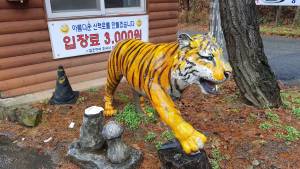 Seonambu, one of the city’s secondary bus stations. Some of the streets surrounding it had a tawdry vibe that was both inviting and menacing. I strolled up and down one of them holding a cheap umbrella—light rain would be a constant on this trip—offered by a lady who happened to see me. When the bright green 34 bus came, I got on.
Seonambu, one of the city’s secondary bus stations. Some of the streets surrounding it had a tawdry vibe that was both inviting and menacing. I strolled up and down one of them holding a cheap umbrella—light rain would be a constant on this trip—offered by a lady who happened to see me. When the bright green 34 bus came, I got on.
Equidistant between Daejeon and Jeonju, 63-square-kilometer Daedunsan Provincial Park is famous for its dramatic rock formations, with sheer cliffs, spires, chimneys and pinnacles above, and deep crevasses and thick foliage below. This place, which resembles a classical Eastern landscape painting, is favored by Korean mountain climbers. A Buddhist temple called Taegosa and the remains of several fortresses sit within its boundary.
The end of the line for this bus was the parking lot of a restaurant and gift shop. On the left side was the longest zipline course (1,377 meters) in Korea. On the right was a historical marker stating that the meadow before me was the site of the Battle of Ichi which took place on August 14, 1592, early in the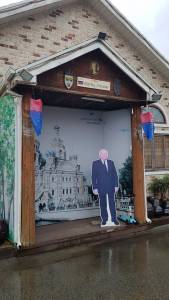 Imjin War. An army of 1,000 Koreans led by Kwon Yul defeated the 2,000 Japanese led by Kobayakawa Takakage. Its main consequence was that the Japanese were prevented from getting into rice-rich Jeolla Province. As an amateur historian, I felt obliged to picture that clash 429 years earlier. (By far the most famous military commander from the Imjin War was Admiral Yi Sun-shin. His heroics on the water are not to be denied, but General Kwon was a tough cookie on land. Their combined efforts eventually forced the number-one samurai, Toyotomi Hideyoshi, to send his troops home.)
Imjin War. An army of 1,000 Koreans led by Kwon Yul defeated the 2,000 Japanese led by Kobayakawa Takakage. Its main consequence was that the Japanese were prevented from getting into rice-rich Jeolla Province. As an amateur historian, I felt obliged to picture that clash 429 years earlier. (By far the most famous military commander from the Imjin War was Admiral Yi Sun-shin. His heroics on the water are not to be denied, but General Kwon was a tough cookie on land. Their combined efforts eventually forced the number-one samurai, Toyotomi Hideyoshi, to send his troops home.)
The lady inside the sikdang told me that a resort of some kind was 10 minutes away, so I walked there. Upon arrival, it sure looked promising. I beheld a miniature tennis court, replicas of tigers, polar bears, horses and other animals, a rock museum and something called “Gorby House” with Russian flags painted on both sides of a cutout of the Soviet Union’s last head of state, Mikhail Gorbachev. This was something I just had to know more about. I dropped my umbrella at the top of some steps and sauntered into a coffee shop. Customers were in abundance, and it took a while for me to draw the proprietor’s attention.
In time, I did. His name was Yoo Ji-heon, and his female helper (his sister) was Yoo Ji-sim. They indicated that one of their pensions next to the Gorby House was available, and I could get it for a 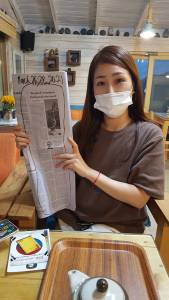 discount. Very good, but I would still be paying 80,000 won, double my ordinary rate; I handed them my credit card. Ji-sim, the mother of an adorable 3-year-boy, offered me a ride in her silver SUV to the cable car that would whisk me up near the top of the 878-meter-high mountain.
discount. Very good, but I would still be paying 80,000 won, double my ordinary rate; I handed them my credit card. Ji-sim, the mother of an adorable 3-year-boy, offered me a ride in her silver SUV to the cable car that would whisk me up near the top of the 878-meter-high mountain.
On the way, she told me an abbreviated version of the “Gorby” story. Her father, Yoo Sung-yeol, had parlayed a family inheritance into a series of adroit real estate purchases, enough to create the Daedunsan Recreational Forest in 1998. He had been a politician himself, once winning election to the Chungcheongnam Province General Assembly. He somehow made the acquaintance of Gorbachev, long since out of power and yet still a very significant personage. During a 2008 UNESCO gathering in Seoul, he came by limousine on roughly the same route I had taken to Daejeon and then to this very resort, spending two nights. Of course, he was feted and stayed at the largest and fanciest of its pensions.
Ji-sim dropped me off at the cable car and told me to call her when I was done. It was rainy and foggy, so the view was severely limited. And at the top, there was more disappointment in store because the suspension bridge strung between four prominent peaks was closed. Unlike my fellow travelers—a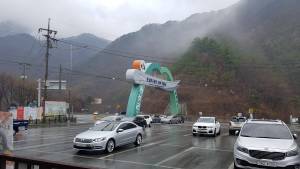 mother, father, teenage daughter and two young sons—I went up a steep and wet metal staircase to get a better view. Not what I might have hoped for, but I was able to behold some of Mama Nature’s wonders.
mother, father, teenage daughter and two young sons—I went up a steep and wet metal staircase to get a better view. Not what I might have hoped for, but I was able to behold some of Mama Nature’s wonders.
Within an hour, Ji-sim had brought me back to the resort. I dried off and returned to the coffee shop where she made me some peppermint tea. I drank it as we talked, with a fire warming the room and large windows on two sides showing mountains and valleys as far as the eye could see. Having lived in Oregon for six years, she had decent English and knew a thing or two about American culture. I told her of my recently published book, the Jikji campaign and the life of an expat in Korea. I remember one comment from Ji-sim in particular. Daejeon (home to 1.5 million people and a high-tech hub) operates at a much slower pace than Seoul. People in the capital talk fast, walk fast, bump into you on the sidewalks and seldom bother with eye contact. So she said.
Her mom, Choi Sun-ja, prepared something for me to take back to my room—a plate of carefully sliced tangerine, apple, pear and strawberries, with some succulent cake and a carton of apple juice on the side.  She also offered to do my laundry, if I had any. Such kindness, but I had to demur. The book I had brought along on this trip and which I read in my pension addressed the 1811–12 earthquakes in New Madrid, Missouri.
She also offered to do my laundry, if I had any. Such kindness, but I had to demur. The book I had brought along on this trip and which I read in my pension addressed the 1811–12 earthquakes in New Madrid, Missouri.
With better weather, I would have used more of Sunday morning and afternoon. For one thing, a friend of Ji-sim’s operated the zipline, and she offered me a free ride on it—quite a bargain at 55,000 won. I would come back on a bright and sunshiny day, I told her.
The 34 bus had just arrived when we got to the restaurant. This was, if you are counting, my third ride in her car. With the rain coming down and the wind blowing, we said a quick goodbye.

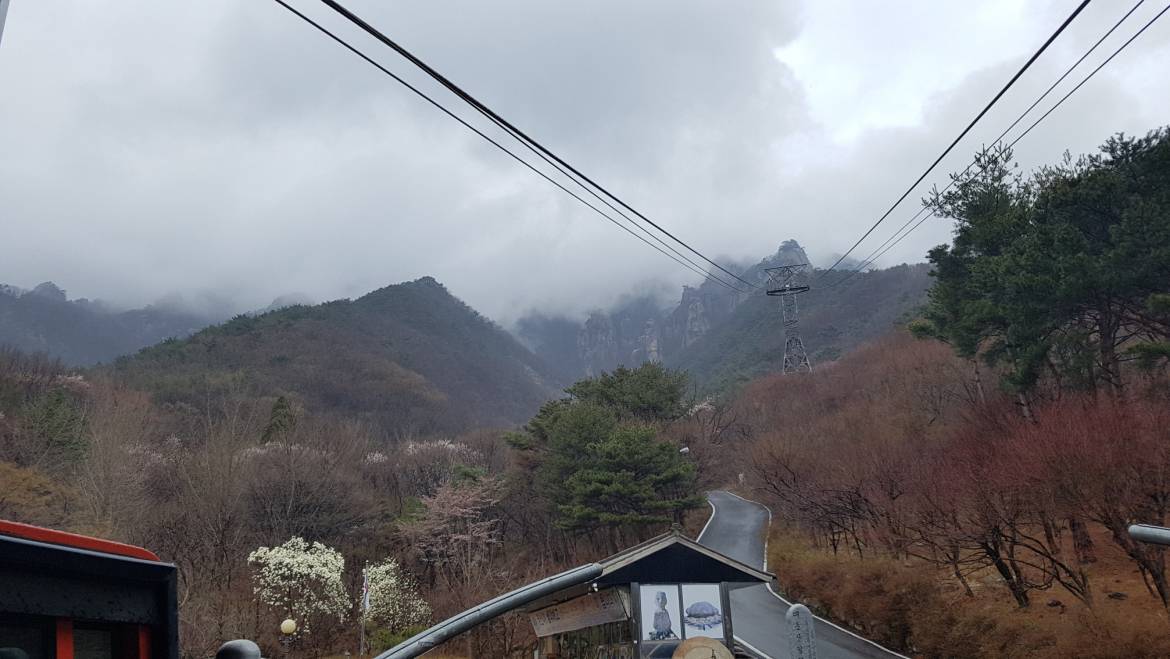
13 Comments
I’m glad you met special people on your trip, Ms. Ji-sim and Choi shes mother, deserve respect for their behavior toward you.
I am glad that you have the opportunity to travel and have good experiences in the country that you have adapted in last years.
Greetings and goodbye!
You are right about that, Elly. Those ladies (and the brother) were very nice and helpful to me. And the scenery with the mountains….beautiful!
Another interesting trip! Oh I can imagine each step u make with how you put ur experience into writing.
I just wish that i can also visit those places🤣😂
Thanks, Myline. That is just what I try to do in my writing (and not bore the reader….boring the reader is the cardinal sin!).
How you described the place and the people you’ve met on this journey, I can say it’s worth the one month delayed trip and a well spent weekend Rich!
Wow, you take such interesting trips, mostly because the three car rides were not pre-planned, the lack of an umbrella borrowed from a stranger, free tangerine, et al fruit bowl, Gorbachev was a visitor…. how do you do it… over and over again… this is why your adventurous tales are so fun to read, it is a total free-spirit ride into the unknown… it is really like a box of chocolates, you never know what you’re going to get
Box of chocolates is about right, Mr. S…. And so what if it rained? That’s part of the deal.
Richard-Sounds like a very interesting trip. The book about the New Madrid earthquake you’re reading brought back memories of my work life. That earthquake and the one in Charleston, S.C., in 1886, informed the seismic structural guidance for US nuclear power plants. The quakes were not anywhere near fault lines, yet they occurred, so all the US nuclear plants were built to withstand severe earthquakes. When an earthquake occurred in Virginia a few years ago with the epicenter just a few miles from a nuclear plant, there was essentially no damage at that plant though the quake did superficial damage as far away as Washington DC. (about 100 miles).
That book included a reference to the Charleston 1886 quake….
Richard:
A wonderful article with, as usual, great detail. In many of your articles, I find them so interesting I almost feel I am with you experiencing what you’re doing. The description of Seoul sounds a lot like New York City.
I actually met Gorbachov at the 1986 Goodwill Games in Moscow. I was working for Turner Broadcasting and we put together a US-USSR series of sports events because of the boycotts in 1980 and 1984.
Rex–if you are able to get any kind of vicarious pleasure from reading this or any other of my stories, I have achieved a high goal. That is just what I seek to do. Agreed, Gorby was quite a guy, a historical figure.
I like how you put your raw experience and transcends it into words. As if my spirit is also experiencing the moment. Great writing always!
Thanks, Bridget!!
Add Comment